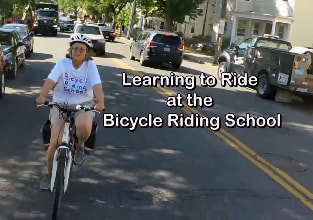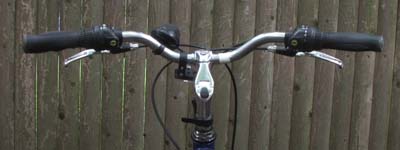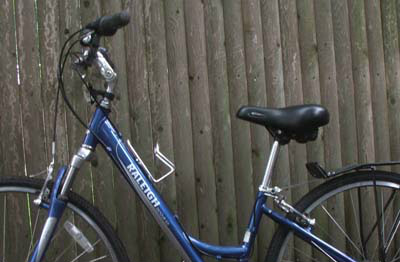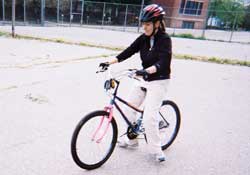Bicycle Riding SchoolSchedule Lesson/Class
Teach Yourself
|
If you are unable to take lessons with us, you may use the instructions below, together with "What's A Beginner's Lesson Like" on the home page (below the Rain and Snow policy) and try on your own. We also have a video about how to learn how to ride a bike.
Here's a recent comment about it: "Many thanks for this video. I got on a bike for the first time on January 1, 2020; two weeks later I was a member of a cycling group and everyone was quite surprised. My secret? This video. Many thanks for such useful, precise and clear information. I now look forward to riding my bike every day. Kind regards from Paris :)" In addition, there are many other teachers around North America listed at the bottom of this page. Be careful and have fun! |
The Best Bikes for Teaching and Learning
The Worst Bikes for Teaching and Learning
Our Method
Use a bike small enough so that you can get your feet flat on the ground while sitting on the seat.
Remove the pedals. (The right pedal screws off the right way, like any jar, but the left pedal screws off the "wrong" way.)
Pedals can be on tight, (since they don't go on and off much, except in our teacher fleet,) so you may need a special (long and thin) pedal wrench. The flat edges of the pedal axle, that you turn to remove the pedals, are too narrow for many adjustable wrenches, but a 15mm box wrench can work. (Any bike store will be happy to take pedals off for you.)
Find a place with a nice wide paved area, ideally with a very gentle slope. If you're working alone, you'll need the slope. If you have a helper, they can just push you around a playground or empty parking lot. Don't start on a path; it's much too narrow.
Sit on your bike and get comfy. Squeeze the brakes. You can ride them all you like. If your hill is at all serious, you'll use them all the time and that's fine.
Sit on the seat and give a little push with your feet to get yourself going. Keep your hands on the brakes and use them whenever necessary to keep yourself going very slowly. People often laugh when they hear me telling someone to slow down; they're going so slowly already by normal standards. Going slow is so great. If anything happens, it's usually no big deal. But there is such a thing as so slow that it's really hard to get your balance. So use your judgment.
If you have a helper, that person should just push you from your lower back, not try to help you stay up. Your feet will take care of that. They should walk at a normal pace.
Give up any idea of going in a straight line or of deciding where the bike will go. You will wiggle at the start, even go in circles sometimes, and there's no way around it. ...Believe me!
Remove the pedals. (The right pedal screws off the right way, like any jar, but the left pedal screws off the "wrong" way.)
Pedals can be on tight, (since they don't go on and off much, except in our teacher fleet,) so you may need a special (long and thin) pedal wrench. The flat edges of the pedal axle, that you turn to remove the pedals, are too narrow for many adjustable wrenches, but a 15mm box wrench can work. (Any bike store will be happy to take pedals off for you.)
Find a place with a nice wide paved area, ideally with a very gentle slope. If you're working alone, you'll need the slope. If you have a helper, they can just push you around a playground or empty parking lot. Don't start on a path; it's much too narrow.
Sit on your bike and get comfy. Squeeze the brakes. You can ride them all you like. If your hill is at all serious, you'll use them all the time and that's fine.
Sit on the seat and give a little push with your feet to get yourself going. Keep your hands on the brakes and use them whenever necessary to keep yourself going very slowly. People often laugh when they hear me telling someone to slow down; they're going so slowly already by normal standards. Going slow is so great. If anything happens, it's usually no big deal. But there is such a thing as so slow that it's really hard to get your balance. So use your judgment.
If you have a helper, that person should just push you from your lower back, not try to help you stay up. Your feet will take care of that. They should walk at a normal pace.
Give up any idea of going in a straight line or of deciding where the bike will go. You will wiggle at the start, even go in circles sometimes, and there's no way around it. ...Believe me!
|
This is the key to learning to balance a bicycle: whichever way you start to lean, turn the front wheel in that same direction, even if it means going in a circle. Follow the bike wherever it wants to go.
See if you can go a little stretch without putting your feet down. But when you need them, there they are to catch you. When you can reliably go for pretty long stretches without using your feet, put the pedals back on. |
Now, everything is different, as far as your legs are concerned. There will be no more reaching casually for the ground without getting hit by a pedal. Now you have to really remember that the pedals are there.
Notice that if the pedals rotate toward the back of the bike, nothing happens. This is how you position the pedal to get going. Pedaling in the forward direction is what makes you go. If you think you'd be comfortable a little higher up, raise the seat so your heels are a little bit off the ground. Pull one pedal up, almost to the top. Put your foot on it and push off. Leave your second foot out to the side for the time being, like it used to be before you had pedals, only further out. Get your balance with that one foot on the pedal. See if you can keep it on for long stretches. You are still following the bike wherever it wants to go. Keep your head up, and look forward and around, but try not to look down much. Mostly look out, into the glorious future. When you feel balanced and comfortable, try to find that second pedal with your second foot. It'll be pretty high. When you find that second pedal, just rest your foot there. Only pedal if you need more speed. Whenever possible, don't pedal, just coast. You may want to raise the seat, if you can. The higher your seat is, the easier it is to get to the second pedal, but the farther away the ground is. Be sure the "ball" of your foot (just behind your toes,) can be firmly on the ground while you're seated. Don't go any higher than that, for now. You are still following the bike, but if it starts to do what you want, all the better. When you find that second pedal, and can pedal when you need more speed, start practicing braking.
Think to yourself, as you're riding, "here are the brakes, if anything funny happens, this is what I squeeze." Reach out and touch the brake levers to get the idea into your fingers. Try to simulate emergencies for yourself and the answer is always "Stop, by squeezing." Hopefully the bike is starting to go where you have in mind. If not, just keep following it around the playground and it will eventually start to go where you want. Once that happens, do figure 8's or, in any case, be sure you can turn both ways. Be sure you can look around while riding. Eventually you want to be able to look all the way around behind you.
This is the basic way that we get people riding bicycles. Once they can get around on the bike, we go on to such things as:
- Understanding the gears and how to change them. Higher gears go farther for your same pedal stroke than low gears, that's why they're harder to pedal. The goal is to find a comfortable speed for your feet to go around.
- Learning to stand up, off the seat, for going over bumps, using your knees as a "shock absorber." Do it while coasting, just adding weight to your bottom foot gently.
- Learning to take a hand off by first loosening your grip. If that works fine, remove your hand so it's just hovering right around the handlebar grip. If that works fine, take it all the way off for short periods of time. Now you can signal for upcoming turns or scratch your nose to your heart's content.
- Raising the seat: Eventually, when you are ready, raise the seat to where your leg is almost straight at the bottom of the pedal stroke. This will require learning to get on and off the bike standing on one pedal, not sitting on the seat. Raising the seat is especially important is you start to go serious distances. If you're biking a lot still down lower than the ideal height, and your knees start to hurt, it is probably because you're too low.
For help starting to ride on roads, contact Aaron Charlwood, if you're in the Boston area, at [email protected] or 617-823-7128 or, if you're not close by, try your local bicycle organization. We recommend riding on paths until things begin to seem very predictable - when the bike reliably goes where you intend for it to go. This is usually a few months at least, but if you ride a lot and it comes easily to you, and you want to push yourself a bit, you might start to see what streets are like sooner than that. Let us know of your experiences and of suggested improvements to these instructions.
Let us know of your experiences with these instructions and of suggested improvements to them. If you learn to ride, please let us know, so that we can keep our count of students up-to-date. If you feel like it, send a check to Susan McLucas at 14 William St, Somerville, MA 02144. All content © 2009-2014 Susan McLucas.
Notice that if the pedals rotate toward the back of the bike, nothing happens. This is how you position the pedal to get going. Pedaling in the forward direction is what makes you go. If you think you'd be comfortable a little higher up, raise the seat so your heels are a little bit off the ground. Pull one pedal up, almost to the top. Put your foot on it and push off. Leave your second foot out to the side for the time being, like it used to be before you had pedals, only further out. Get your balance with that one foot on the pedal. See if you can keep it on for long stretches. You are still following the bike wherever it wants to go. Keep your head up, and look forward and around, but try not to look down much. Mostly look out, into the glorious future. When you feel balanced and comfortable, try to find that second pedal with your second foot. It'll be pretty high. When you find that second pedal, just rest your foot there. Only pedal if you need more speed. Whenever possible, don't pedal, just coast. You may want to raise the seat, if you can. The higher your seat is, the easier it is to get to the second pedal, but the farther away the ground is. Be sure the "ball" of your foot (just behind your toes,) can be firmly on the ground while you're seated. Don't go any higher than that, for now. You are still following the bike, but if it starts to do what you want, all the better. When you find that second pedal, and can pedal when you need more speed, start practicing braking.
Think to yourself, as you're riding, "here are the brakes, if anything funny happens, this is what I squeeze." Reach out and touch the brake levers to get the idea into your fingers. Try to simulate emergencies for yourself and the answer is always "Stop, by squeezing." Hopefully the bike is starting to go where you have in mind. If not, just keep following it around the playground and it will eventually start to go where you want. Once that happens, do figure 8's or, in any case, be sure you can turn both ways. Be sure you can look around while riding. Eventually you want to be able to look all the way around behind you.
This is the basic way that we get people riding bicycles. Once they can get around on the bike, we go on to such things as:
- Understanding the gears and how to change them. Higher gears go farther for your same pedal stroke than low gears, that's why they're harder to pedal. The goal is to find a comfortable speed for your feet to go around.
- Learning to stand up, off the seat, for going over bumps, using your knees as a "shock absorber." Do it while coasting, just adding weight to your bottom foot gently.
- Learning to take a hand off by first loosening your grip. If that works fine, remove your hand so it's just hovering right around the handlebar grip. If that works fine, take it all the way off for short periods of time. Now you can signal for upcoming turns or scratch your nose to your heart's content.
- Raising the seat: Eventually, when you are ready, raise the seat to where your leg is almost straight at the bottom of the pedal stroke. This will require learning to get on and off the bike standing on one pedal, not sitting on the seat. Raising the seat is especially important is you start to go serious distances. If you're biking a lot still down lower than the ideal height, and your knees start to hurt, it is probably because you're too low.
For help starting to ride on roads, contact Aaron Charlwood, if you're in the Boston area, at [email protected] or 617-823-7128 or, if you're not close by, try your local bicycle organization. We recommend riding on paths until things begin to seem very predictable - when the bike reliably goes where you intend for it to go. This is usually a few months at least, but if you ride a lot and it comes easily to you, and you want to push yourself a bit, you might start to see what streets are like sooner than that. Let us know of your experiences and of suggested improvements to these instructions.
Let us know of your experiences with these instructions and of suggested improvements to them. If you learn to ride, please let us know, so that we can keep our count of students up-to-date. If you feel like it, send a check to Susan McLucas at 14 William St, Somerville, MA 02144. All content © 2009-2014 Susan McLucas.
Other Teachers
Zerowaste.org has a complete learn-to-ride curriculum.
Search for other local resources and instructors at The League of American Bicyclists, especially for road riding.
California
San Francisco, Oakland, Alameda, San Mateo, Palo Alto, Sunnyvale, Marin County:
Bicycle Solutions, John Ciccarelli (Owner), lessons(at)bicyclesolutions.com, (415) 912-6999
San José: Herman Wadler, League of American Bicyclists cycling instructor, hwadler(at)wadler.org
Long Beach: Chris Quint, League of American Bicyclists cycling instructor, lci_chris(at)yahoo.ca , (562) 433-5220
Colorado
Denver: Bicycle Colorado's Bike School
Fort Collins: Allan Dunlop, Center for Cycling Education, education(at)thecce.org
Florida
Oviedo (north of Orlando): Tammy Bishop, Occupational Therapist, understands the fear adults and children feel when learning
how to pedal a bicycle. She offers relaxed and supportive private lessons to adults, children, and those with disabilities.
tamsbooks4kids(at)gmail.com, (407) 542-4681
Georgia
Atlanta: Atlanta Bicycle Coalition, gives classes and will arrange private teachers for beginners.
Illinois
Chicago: Learn to Ride program offered by City of Chicago Safe Ambassadors. Register for ages 7-12 classes or ages 13+ classes.
Chicago area: Larry Mysz knows a number of League of American Bicyclists-certified instructors who teach beginners. He will refer people to the nearest one. Larry(at)customized-applications.com , (708) 754-7859
Louisiana
New Orleans: Bike Easy
Maryland
Baltimore: Easy Bike Lessons
Michigan
Southeast: PEAC (Program to Educate All Cyclists) Though created mostly for the disabled, PEAC teaches anyone to ride.
Missouri
Kansas City: BikeWalkKC
New Jersey
Montclair: Jeff Mickiewicz teaches beginners through Bike & Walk Montclair .
Newark: Girls On Bikes, a Non Profit, located in Newark, NJ that conducts leadership and empowerment workshops, teaches youth
how to build bicycles from scratch, and teaches people of all ages and gender identities how to ride bicycles. You can contact them
at gobnewark(at)gmail.com and (862) 218 0353
Northern and Central: Sandie Reilly teaches beginners to ride bikes, including those with disabilities.
Contact her at Sandie(at)SandieReilly.com or (908) 501-3842.
New York
NYC: BikeNewYork.org, Rich Conroy, classes(at)bike.nyc or RConroy(at)bike.nyc, (212) 870-2080
Lance Jacobs, (NYC) League Certified Instructor, Adult Learn-to-Ride , Lance(at)VirtuousBicycle.com
Syosset (Long Island): Howard Roth, howard(at)RidingMadeEasy.com
Various locations in NY: Professor Pedals
Ohio
Toledo: Al Thompson, apt(at)bex.net, (419) 517-3438
Oregon
Portland: The Street Trust encourages and supports biking in Portland
Pennsylvania
Philadelphia: The Bicycle Coalition of Greater Philadelphia teaches adults to ride; choose Adult Learn To Ride at this link or call (215) 242-9253.
Tennessee
Nashville: Walk Bike Nashville, Program Coordinator Jessica Burton, Jessica(at)walkbikenashville.org, 1101 17th Ave. South,
(615) 379-7252.
Nashville: Bike Fun, KJ Garner, kj(at)nashvillebikefun.com.
Texas
Austin: Preston Tyree, League of American Bicyclists-certified instructor, safecyclist(at)gmail.com, (512) 338-4075
Doug Ballew, startbikingtoday(at)gmail.com
Michelle LeBlanc michelle(at)michelleleblancyoga.com
Dallas: Bike Dallas/Ft. Worth organizes classes for beginners about every month, education(at)bikedfw.org.
Houston: Bike Houston resources and events
Washington
Bremerton: Brian Watson
Seattle: Cascade Bicycle Club offers a variety of learning opportunities
Washington, DC and Northern Virginia
Arlington: BikeArlington, info(at)bikearlington.com or (703) 725-1909 (Sign up on Events calendar)
DC: Washington Area Bicyclist Association Has beginning riding classes called "L2R" (Learn To Ride), (202) 518-0524
Reston: Fairfax Alliance for Better Bicycling , info(at)fabb-bikes.org.
Canada
Can-Bike, a Canadian cycling education program (event calendar, links)
Search for other local resources and instructors at The League of American Bicyclists, especially for road riding.
California
San Francisco, Oakland, Alameda, San Mateo, Palo Alto, Sunnyvale, Marin County:
Bicycle Solutions, John Ciccarelli (Owner), lessons(at)bicyclesolutions.com, (415) 912-6999
San José: Herman Wadler, League of American Bicyclists cycling instructor, hwadler(at)wadler.org
Long Beach: Chris Quint, League of American Bicyclists cycling instructor, lci_chris(at)yahoo.ca , (562) 433-5220
Colorado
Denver: Bicycle Colorado's Bike School
Fort Collins: Allan Dunlop, Center for Cycling Education, education(at)thecce.org
Florida
Oviedo (north of Orlando): Tammy Bishop, Occupational Therapist, understands the fear adults and children feel when learning
how to pedal a bicycle. She offers relaxed and supportive private lessons to adults, children, and those with disabilities.
tamsbooks4kids(at)gmail.com, (407) 542-4681
Georgia
Atlanta: Atlanta Bicycle Coalition, gives classes and will arrange private teachers for beginners.
Illinois
Chicago: Learn to Ride program offered by City of Chicago Safe Ambassadors. Register for ages 7-12 classes or ages 13+ classes.
Chicago area: Larry Mysz knows a number of League of American Bicyclists-certified instructors who teach beginners. He will refer people to the nearest one. Larry(at)customized-applications.com , (708) 754-7859
Louisiana
New Orleans: Bike Easy
Maryland
Baltimore: Easy Bike Lessons
Michigan
Southeast: PEAC (Program to Educate All Cyclists) Though created mostly for the disabled, PEAC teaches anyone to ride.
Missouri
Kansas City: BikeWalkKC
New Jersey
Montclair: Jeff Mickiewicz teaches beginners through Bike & Walk Montclair .
Newark: Girls On Bikes, a Non Profit, located in Newark, NJ that conducts leadership and empowerment workshops, teaches youth
how to build bicycles from scratch, and teaches people of all ages and gender identities how to ride bicycles. You can contact them
at gobnewark(at)gmail.com and (862) 218 0353
Northern and Central: Sandie Reilly teaches beginners to ride bikes, including those with disabilities.
Contact her at Sandie(at)SandieReilly.com or (908) 501-3842.
New York
NYC: BikeNewYork.org, Rich Conroy, classes(at)bike.nyc or RConroy(at)bike.nyc, (212) 870-2080
Lance Jacobs, (NYC) League Certified Instructor, Adult Learn-to-Ride , Lance(at)VirtuousBicycle.com
Syosset (Long Island): Howard Roth, howard(at)RidingMadeEasy.com
Various locations in NY: Professor Pedals
Ohio
Toledo: Al Thompson, apt(at)bex.net, (419) 517-3438
Oregon
Portland: The Street Trust encourages and supports biking in Portland
Pennsylvania
Philadelphia: The Bicycle Coalition of Greater Philadelphia teaches adults to ride; choose Adult Learn To Ride at this link or call (215) 242-9253.
Tennessee
Nashville: Walk Bike Nashville, Program Coordinator Jessica Burton, Jessica(at)walkbikenashville.org, 1101 17th Ave. South,
(615) 379-7252.
Nashville: Bike Fun, KJ Garner, kj(at)nashvillebikefun.com.
Texas
Austin: Preston Tyree, League of American Bicyclists-certified instructor, safecyclist(at)gmail.com, (512) 338-4075
Doug Ballew, startbikingtoday(at)gmail.com
Michelle LeBlanc michelle(at)michelleleblancyoga.com
Dallas: Bike Dallas/Ft. Worth organizes classes for beginners about every month, education(at)bikedfw.org.
Houston: Bike Houston resources and events
Washington
Bremerton: Brian Watson
Seattle: Cascade Bicycle Club offers a variety of learning opportunities
Washington, DC and Northern Virginia
Arlington: BikeArlington, info(at)bikearlington.com or (703) 725-1909 (Sign up on Events calendar)
DC: Washington Area Bicyclist Association Has beginning riding classes called "L2R" (Learn To Ride), (202) 518-0524
Reston: Fairfax Alliance for Better Bicycling , info(at)fabb-bikes.org.
Canada
Can-Bike, a Canadian cycling education program (event calendar, links)
If you know of other places to learn to ride, let us know, and we'll add them to our list here.
Also, if you use one of these places, please let us know how it went.
Also, if you use one of these places, please let us know how it went.






